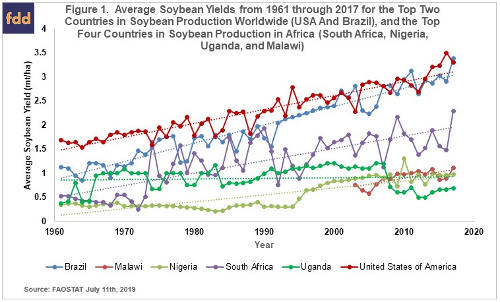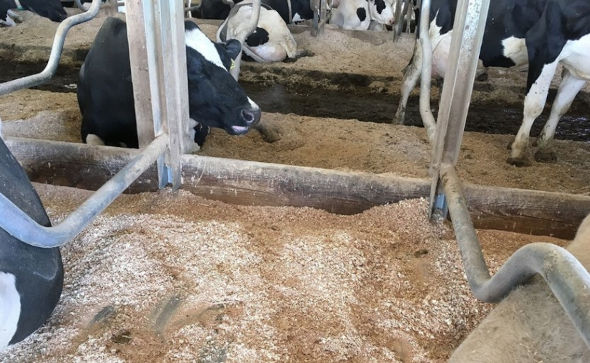By Brian Diers,Andrew Scaboo
USAID’s Feed the Future Lab for Soybean Value Chain Research, aka the Soybean Innovation Lab (SIL), is a research for development project begun in 2013. The team of 40 US researchers work in 17 countries, most of which are in Sub-Saharan Africa. The University of Illinois is the lead institution, accompanied by the University of Missouri and Mississippi State University. Recently, farmdoc asked SIL to provide a series of articles describing the state of soybean development in Sub-Saharan Africa. This series of articles describes the current state of soybean in Africa from the multiple disciplines that comprise the Soybean Innovation Lab. Peter Goldsmith is the Principal Investigator at the Soybean Innovation Lab. Feel free to reach out to Amy Karagiannakis at the Soybean Innovation Lab at oybeaninnovationlab@mx.uillinois.edu for more information on any of the topics, or if you would like to collaborate with the team.
Soybean is the most important legume crop worldwide and is grown mainly for its protein and oil rich seed, yet soybean production in Africa has largely lagged behind the increases made in the western hemisphere. Soybean has a long history in Africa with its first production on the continent reported during 1858 in Egypt and the first recorded production in sub-Saharan Africa (SSA) in South Africa during 1903 (Shurtleff & Aoyagi, 2009). Despite this history and large areas suitable for the crop, soybean yields in the top soybean producing countries in Africa, other than South Africa, have increased little over the last 55 years especially when compared to the USA and Brazil (Figure 1). These low yields in SSA have resulted in poor profitability for farmers which has disincentivized soybean production. The low yields result from a number of factors such as the lack of improved, adapted varieties, poor agronomic practices, and infertile soils. Despite the current productivity limitations, Foyer et al. (2018) suggests that Africa holds tremendous potential for increasing sustainable soybean production, even in the face of a changing global climate.

Based on a survey completed in 2010, Alene, Abdoulaye, Rusike, Manyong, and Walker (2015) reported that there were only 13.2 full-time equivalent staff engaged in soybean improvement in the public sector across SSA. Over the past five years, the Soybean Innovation Lab (SIL) has helped breeding programs in Africa improve their ability to develop varieties by building capacity through providing technical expertise and funding to support breeding efforts and purchase equipment. These activities have been focused on the programs of the International Institute for Tropical Agriculture (IITA) located in Zambia and Nigeria, the Savanna Agricultural Research Institute (SARI) in northern Ghana, the Ethiopian Institute of Agricultural Research (EIAR), and recently support has been provided to Makerere University (Figure 2).

There are unique challenges that breeding programs in Africa have faced in developing high yielding varieties adapted to African environments. The latitude of most target environments in Africa are within 20o of the equator, therefore, breeders need to develop varieties adaptation to these low latitude tropical environments. Because of the daylength sensitivity of soybean, the short-day length in these latitudes results in soybean adapted to higher latitude temperate regions to flower and mature too early to yield well. Therefore, germplasm with reduced day length sensitivity needs to be bred and selected in SSA. In addition to latitude, breeders must consider variation in the elevation of production environments in Africa as cooler temperatures at higher elevations will slow maturity compared to low elevation environments.
Breeding for resistance to biotic stresses, particularly Asian soybean rust, has been a major focus for many breeding programs Africa. Losses caused by Asian soybean rust can be as great as 90% (Murthi, Beed, Tukamuhabwa, Thomma, & Joosten, 2016) and durable resistance is difficult to achieve due to variation in the pathogen resulting in rapid defeat of major resistance genes. Breeders have responded to this threat by developing varieties that have moderate resistance or tolerance to the disease (Murthi et al., 2016). Another trait that breeders have focused on in Africa is promiscuous nodulation. This trait is needed because most farmers in Africa do not have access to the correct rhizobium inoculant needed for most soybean plants to nodulate and fix nitrogen. Promiscuous soybean can fix nitrogen with strains of rhizobium indigenous to Africa, making it an important trait for resource poor farmers (Tefera, 2011).
The IITA soybean breeding program fulfills a critical role in developing soybean varieties adapted throughout SSA (Khojely, Ibrahim, Sapey & Han, 2018). The program was initiated in 1974 using high yielding germplasm from North America and other regions of the world combined with promiscuously nodulating germplasm from Asia (Tefera, 2011), and the IITA breeding program has been successful in improving the yield of soybean varieties grown throughout SSA. Tefera, Kamara, Asafo-Adjei, and Dashiell (2009) grew a set of soybean lines released by IITA from 1980 to 1996 in trials in Nigeria and showed that the yield potential of varieties increased from 16.61 to 25.43 bsh/ac-1 with a genetic gain of .36 bsh/ac-1 year-1. In addition to the greater yield potential, the new varieties had reduced lodging and shattering and improved nodulation.
The soybean variety development program at Makerere University has been successful in developing varieties adapted to East Africa. Makerere University has released several varieties and the most recent release is Maksoy 6N. In recent Pan African Variety Tests in Uganda and Rwanda, the varieties from Makerere University were among the highest yielding entries (Click
here for more information). The soybean breeding programs located at SARI and at EIAR are relatively new and are developing and testing new experimental lines, but have not yet developed and released their own experimental lines.
In addition to the public breeding programs just mentioned, there are also private breeding programs that develop soybean varieties in Africa. The company Seed Co has a significant soybean breeding program based in Zimbabwe and they develop varieties that are adapted to many soybean growing regions across Africa, and their varieties and experimental lines are performing well in the Pan African Soybean Variety Tests.
Soybean is a crop with great potential in Africa, but to realize this potential, investment is needed to develop the varieties and agronomic practices to improve yields in the varied environments on the African continent. SIL is investing in breeding programs that develop varieties for Africa, but even with these investments, the overall breeding effort in Africa is small relative to developed countries. Breeders should be able to take advantage of advances and technologies that have improved yields in other countries to make relatively quick yield improvements in Africa if proper investments are made. For example, progress could be made by using germplasm developed in North and South America as sources of high yield in breeding programs in Africa, by increasing the number of crops grown per year, or through using newly developed breeding technologies such as genomic selection.